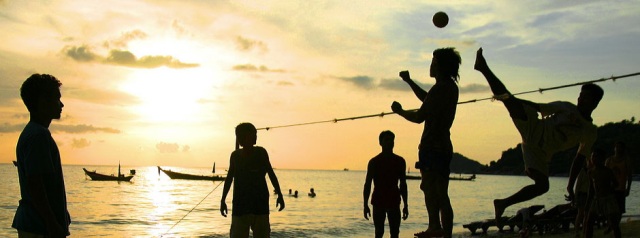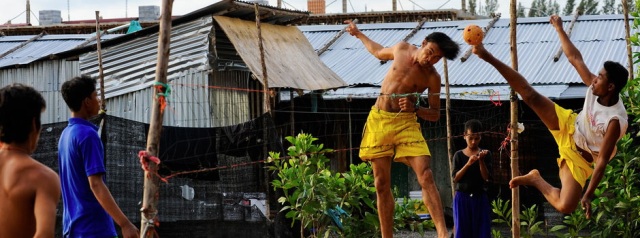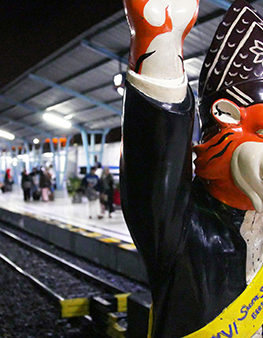Published on May 27, 2014

Sepak takraw has long remained one of Asia’s best-kept secrets. Often described as a spectacular blend of volleyball, football, martial arts and gymnastics, sepak takraw is a sport unlike any other. Most closely resembling volleyball in terms of there being two teams on a court divided by a high net, sepak takraw differs in its use of a light rattan ball and only allows players to use their feet, knees, chest and head to touch the ball. Astonishingly visceral and explosive, sepak takraw or kick volleyball is one of the toughest games in the world demanding lightning reflexes, precise control and fearless, gravity-defying leaps.
The earliest versions of the sport were like games of “keep-uppies”; individual demonstrations of skill to prevent the ball from hitting the ground and/or efforts by groups of players to pass the ball around aerially. Nowadays a sepak takraw match is more competitive, played by two opposing regus (teams) each consisting of three players. One player, the “tekong”, hangs back while his/her teammates, the “left inside” and “right inside” stay at the net. As in volleyball the regu that lets the ball hit the ground concedes a point to their opponents. “Doubles regu” has two players per team rather than three.

Historical records point to early versions of the sport being played in 16th century Thailand, at the Malaysian royal court a century before that, and across the Philippines, Brunei, Myanmar, Indonesia and Laos as far back as the 11th century. The origin debate evokes strong passions, which obscure the fact that the sporting values of sepak takraw resonate across Southeast Asian national divides and cultural traditions.
These sporting and cultural threads were finally united in the early 1960s, with the establishment of the first codified set of sepak takraw playing rules. The naming of the sport was a compromise between Malaysia and Thailand, the two superpowers of the sport. “Sepak” is the Malay word for kick and “takraw” is the Thai word for a woven ball, therefore sepak takraw quite literally means to kick ball. It is also known in English as kick volleyball.

Over time, unique playing styles have evolved, with different countries developing distinct and fascinating approaches to the game. The sport encourages creativity and innovation. For example the revolutionary horse-kick serve developed in Thailand has flourished in both the men’s and the women’s games. In Vietnam, the equally balletic and graceful cartwheel serve has been employed with lethal precision by many stars.
The King’s Cup in Thailand and the Khir Johari Cup in Malaysia have, for more than 25 years, served as the beacons of light for the international development of the sepak takraw. Organised by the Takraw Association of Thailand, the King’s Cup is an annual celebration of the sport, the largest international sepak takraw festival, and thede facto point-of-entry for inductees into the sport.
In 1965, sepak takraw made its first appearance as a medal sport at the Southeast Asian Peninsular Games (the forerunner of the Southeast Asian Games or SEA Games). The formation of the International Sepak Takraw Federation (ISTAF) in 1988 was quickly followed by an invitation to join the Olympic Movement at the 10th Asian Games in Beijing in 1990. At writing (Jan 2014) Thailand currently ranks number one in the world in both men’s and women’s sepak takraw.
Wherever it has taken root, sepak takraw enjoys cult status. Southeast Asia may be the birthplace of the sport and the stage for its greatest champions, but an enormous variety of regional tournaments and domestic events have sprung up around the globe. From the Sepak Takraw Swiss Open and the Chicken’s Cup in Germany to the Junior National Sepak Takraw Championship in India, the proliferation of competition has grown the talent pool substantially.
Today international teams from more than 25 countries across five continents regularly compete. And with the launch of the first-ever ISTAF World Cup and the ISTAF SuperSeries, Sepak takraw is finally developing footholds in East and South Asia, the Americas, Europe, and Oceania. Not a very well kept secret these days, sepak takraw is poised to go global.
Far from the clubs, competitions, commercialization, and coverage, and in the courtyards, vacant lots, streets, and village commons of Southeast Asia’s heartlands you will find rough and ready games of sepak takraw in action. Keep your eyes peeled and prepare to be amazed!
Sources:http://www.sepaktakraw.org/ (including pics); http://en.wikipedia.org/wiki/Sepak_takraw;






